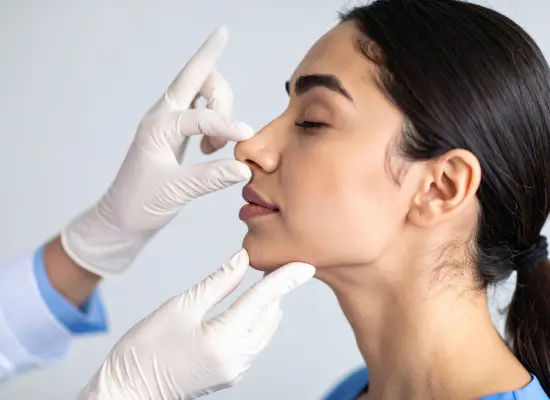Recovery time after rhinoplasty may be different for every patient. Swelling may remain for 4-6 weeks after surgery. Avoid lifting heavy objects, bending, or sleeping on the side for the first week. Bruising and colour changes may occur around the nose while it is healing. The swelling will start reducing slowly after one to three months. Minimum swelling may still be present for up to a year after surgery.

Introduction
Rhinoplasty is a type of cosmetic or reconstructive surgery that changes the shape and size of the nose. Some people choose cosmetic rhinoplasty to improve their face and nose look. Others undergo functional rhinoplasty to improve breathing and nasal function. Gleneagles Hospitals is the best hospital for rhinoplasty surgery in Bangalore.
What Is Rhinoplasty?
Rhinoplasty is a surgical procedure also called a “nose job” to change the shape, size, or function of the nose. It is one of the most popular cosmetic or reconstructive surgeries. People choose this surgery for aesthetic reasons, medical necessity, or post-traumatic reconstruction.
What Are The Types of Rhinoplasty?
Rhinoplasty is of different types depending on the specific goals:
- Open rhinoplasty: In open rhinoplasty, an incision is made along the tissue between the nostrils. The surgeon lifts the skin to expose the underlying parts. It is recommended for complex cases as it helps to make precise changes. It leaves a very small scar.
- Close rhinoplasty: In closed rhinoplasty, incisions are made inside the nostrils, and no scars are visible. It is used to make minor changes and helps in quick recovery.
- Revision rhinoplasty: It is a corrective procedure done after a previous rhinoplasty that did not give the desired results. It can alter the nasal anatomy and can lead to scar tissue formation.
- Non-surgical rhinoplasty: It is a non-invasive procedure in which dermal fillers are used to change the shape of the nose. It is useful for filling minor depressions or lifting nasal tips. It does not affect nose functions and may last for 6-12 months.

Why is Rhinoplasty Done?
Rhinoplasty is done for different reasons, including:
1. Cosmetic reasons: Many people choose rhinoplasty for cosmetic reasons, that is, to improve face aesthetics. Common cosmetic reasons for rhinoplasty are:
- To address the droopy, bulbous, or asymmetrical nasal tip.
- To reduce a prominent bump present on the nasal bridge.
- To narrow down or widen the nasal width for facial balance.
- Change the nostril shape to one that looks too large or flared.
- To correct facial asymmetry.
2. Functional reasons: Many people also choose rhinoplasty to improve nasal function. Functional reasons for rhinoplasty include the following:
- Some people have a misaligned nasal septum that obstructs the airflow. Rhinoplasty helps to correct the deviated nasal septum.
- Some people have a narrow or weak nasal passage, which obstructs breathing.
- Some people suffer from severe nasal congestion due to enlarged turbinates or other structural deformities.
3. Reconstructive reasons: Reconstructive rhinoplasty is recommended in the following cases:
- If nasal fractures or deformities occur due to accidents or sports injuries.
- Children suffering from birth defects such as cleft lip or palate that affect the nasal structure.
- Restoring the shape of the nose after other surgeries.
Your health matters – get expert advice today.
Rhinoplasty Procedure
1. Before rhinoplasty: First, you have to consult with a surgeon for an initial consultation. This will help you ask questions, and the doctor can explain the procedure and the results you hope to achieve. The doctor can examine and measure your nose and can take photographs. You can discuss surgery options, outcomes, and risks.
You must tell the doctor about your current medications and dosages. You will be asked to stop some medications a few days before the procedure. You also have to stop smoking and drinking alcohol before the procedure.
2. During Rhinoplasty Procedure: Rhinoplasty is mostly done in an outpatient department. You can return home the same day.
- The doctor will give you local or general anaesthesia, depending on the type of rhinoplasty.
- During rhinoplasty, the surgeon will make an incision either inside or outside the nose.
- The surgeon raises the skin covering of your nasal bones and cartilage to reduce, add, or rearrange the underlying structure to give a new shape or correct the deviated septum.
- The doctor replaces the skin covering your nasal bones and cartilage and secures the skin using small stitches.
- It may take about one to three hours to complete the procedure.
3. After Rhinoplasty: After rhinoplasty, a small plastic splint is placed to reduce swelling and maintain the new shape of your nose. You will have to wear the splint for one to two weeks.
A cotton gauze is placed inside the nose. It can be removed within a day or two.
Swelling and bruising may occur around the nose and eyes, and it may take several weeks to go. Mild facial swelling may occur in the morning for up to a year after surgery.
Risks And Benefits Of Rhinoplasty
The benefits of rhinoplasty include the following:
- It changes the shape and size of the nose.
- It improves the facial appearance.
- It helps to improve breathing.
- It helps to correct structural abnormalities of the nose such as a deviated septum.
Risks of rhinoplasty: All surgical procedures carry some risks. Some risks associated with rhinoplasty include the following:
- A hole may occur in the nasal septum.
- There is a risk of infection.
- Frequent nosebleeds may occur after surgery.
- Healing may take time and scarring can occur
- Persistent swelling and numbness may occur in the nasal region
- Skin discoloration may occur
- Surgery may not give satisfactory results
- Additional surgery may be required
Why Choose Gleneagles Hospitals For Rhinoplasty?
Gleneagles Hospital is the best hospital for rhinoplasty in Bangalore. It offers comprehensive plastic and reconstructive surgery services such as rhinoplasty. The hospital has the best rhinoplasty surgeon in Bangalore. The reasons to choose Gleneagles Hospitals are:
- Experienced and qualified surgeons: The hospital has a team of highly experienced and qualified plastic surgeons. The surgeons consult with the patients and thoroughly explain the procedure and the best outcomes before doing the procedure. They make a unique treatment plan for every patient to get the best results.
- Comprehensive treatment options: Gleneagles Hospital offers comprehensive treatment options for the patients. The hospital offers a wide range of plastic and reconstructive surgery options to provide personalized and tailored treatment for all patients.
- State-of-the-art infrastructure: The hospital has state-of-the-art infrastructure. The hospital has well-equipped labs, surgery rooms, and recovery rooms to provide appropriate patient care and treatment. The surgeons use the latest techniques for performing different types of surgeries.
- Follow-up care: The hospital has facilities for providing proper follow-up care to every patient for quick and positive healing after surgery. The doctors, nurses, and other hospital staff work together with the patients throughout the surgical procedure till recovery.
Conclusion
Rhinoplasty is a customisable and transformative surgery done to improve aesthetics or functions. It is a major decision and should be made carefully. You must know the recovery time and risks before making a decision. Therefore, consult with the best doctor for rhinoplasty in Bangalore to get the best results.
Our Doctors
View allFrequently Asked Questions
Your body may react to surgery in different ways. Asymmetrical healing is a way how your body reacts to surgery. In asymmetrical healing, swelling may occur on one side of your nose. This will alter the shape of your nose. It is a way of recovery, and it may occur for the first few weeks after surgery.
After rhinoplasty, the surgeon may give you a long-acting numbing agent. You may feel mild pain or discomfort after the procedure. The pain should go away after a few days or a week after surgery. The doctor may give you over-the-counter pain medications to relieve pain and discomfort.
You can take the following precautions to speed up recovery after rhinoplasty:
- Apply a cool compress to the cheeks and under the eyes but not directly to your nose.
- Avoid any blow to your nose.
- Avoid putting too much pressure on the nose while wearing sunglasses or eyeglasses.
- Avoid going too much in the sun
- Keep your head elevated when sleeping
- Avoid blowing your nose
- Avoid lifting heavy objects for 3-4 weeks after surgery.
- Avoid strenuous exercises or activities for 3-4 weeks after surgery.
- Avoid bending your head downwards, as it can put pressure on the nose.
You may see a difference in the appearance of your nose after a week when the splint is taken off. It may take up to a year to see the overall results or a new shape of your nose. During this period, you may experience mild swelling. People who have functional rhinoplasty to fix the deviated septum may see the results within six weeks.











